air conditioning Hyundai Accent 2010 Owner's Manual
[x] Cancel search | Manufacturer: HYUNDAI, Model Year: 2010, Model line: Accent, Model: Hyundai Accent 2010Pages: 284, PDF Size: 10.23 MB
Page 9 of 284
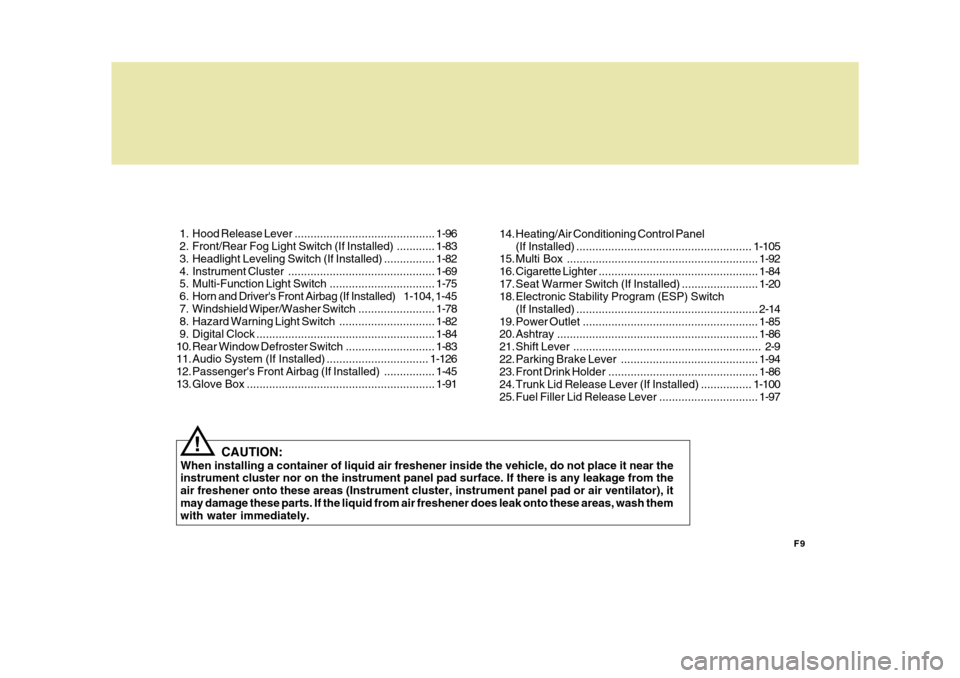
F9
1. Hood
Release Lever ............................................ 1-96
2. Front/Rear Fog Light Switch (If Installed) ............ 1-83
3. Headlight Leveling Switch (If Installed) ................ 1-82
4. Instrument Cluster.............................................. 1-69
5. Multi-Function Light Switch................................. 1-75
6. Horn and Driver's Front Airbag (If Installed) 1-104, 1-45
7. Windshield W iper/Washer Switch ........................1-78
8. Hazard Warning Light Switch.............................. 1-82
9. Digital Clock ........................................................ 1-84
10. Rear Window De froster Switch ............................ 1-83
11. Audio System (If Installed) ................................ 1-126
12. Passenger's Front Airbag (If Installed) ................1-45
13. Glov e Box ........................................................... 1-91
CAUTION:
When installing a container of liquid air freshener inside the vehicle, do not place it near the instrument cluster nor on the instrument panel pad surface. If there is any leakage from the air freshener onto these areas (Instrument cluster, instrument panel pad or air ventilator), itmay damage these parts. If the liquid from air freshener does leak onto these areas, wash them with water immediately.
! 14. Heating/Air Conditioning Control Panel
(If Installed) ....................................................... 1-105
15. Multi Box ............................................................ 1-92
16. Cigarette Lighter .................................................. 1-84
17. Seat Warmer Switch (If Installed) ........................ 1-20
18. Electronic Stability Program (ESP) Switch
(If Installed) ......................................................... 2-14
19. Power Outlet ....................................................... 1-85
20. Ashtray ............................................................... 1-86
21. Shift Lever ........................................................... 2-9
22. Parking Brake Lever ........................................... 1-94
23. Front Drink Holder ............................................... 1-86
24. Trunk Lid Release Lever (If Installed) ................1-100
25. Fuel Filler Lid Release Lever ...............................1-97
Page 11 of 284

F11
CAUTION:
When installing a container of liquid air freshener inside the vehicle, do not place it near the instrument cluster nor on the instrument panel pad surface. If there is any leakage from the air freshener onto these areas (Instrument cluster, instrument panel pad or air ventilator), it may damage these parts. If the liquid from air freshener does leak onto these areas, wash themwith water immediately.
!
1. Hood
Release Lever ............................................ 1-96
2. Front/Rear Fog Light Switch (If Installed) ............ 1-83
3. Headlight Leveling Switch (If Installed) ................ 1-82
4. Instrument Cluster.............................................. 1-69
5. Multi-Function Light Switch................................. 1-75
6. Horn and Driver's Front Airbag (If Installed) . 1-104,1-45
7. Windshield W iper/Washer Switch ........................1-78
8. Hazard Warning Light Switch.............................. 1-82
9. Digital Clock ........................................................ 1-84
10. Rear Window De froster Switch ............................ 1-83
11. Audio System (If Installed) ................................ 1-126
12. Passenger's Front Airbag (If Installed) ................1-45
13. Glov e Box ........................................................... 1-9114. Heating/Air Conditioning Control Panel
(If Installed) ....................................................... 1-105
15. Multi Box ............................................................ 1-92
16. Cigarette Lighter .................................................. 1-84
17. Seat Warmer Switch (If Installed) ........................ 1-20
18. Electronic Stability Program (ESP) Switch (If Installed) ......................................................... 2-14
19. Power Outlet ....................................................... 1-85
20. Ashtray ............................................................... 1-86
21. Shift Lever ........................................................... 2-9
22. Parking Brake Lever ........................................... 1-94
23. Front Drink Holder ............................................... 1-86
24. Trunk Lid Release Lever (If Installed) ................1-100
25. Fuel Filler Lid Release Lever ...............................1-97
Page 118 of 284

1FEATURES OF YOUR HYUNDAI
106
This is used to select fresh outside air or recirculating inside air.FreshRecirculation
With the "
" mode selected, air en-
ters the vehicle from outside and is heated or cooled according to the other functions selected. With the "
" mode selected, air from
within the passenger compartment is drawn through the heating system and heated or cooled according to the otherfunctions selected.
HEATING AND VENTILATION
B670A02A-GAT
(If Installed)
1. Temperature control
2. Air conditioning switch
3. Air intake control switch
4. Air flow control
5. Fan speed control B670B01A-AAT Fan Speed Control (Blower Control) This is used to turn the blower fan on or off and to select the fan speed. This blower fan speed, and thereforethe volume of air delivered from the system, may be controlled manually by setting the blower control betweenthe "1" and "4" positions. B670C03A-AAT Air Intake Control Switch
B670A01MC-D
OMC025083B670C02MC
Page 121 of 284
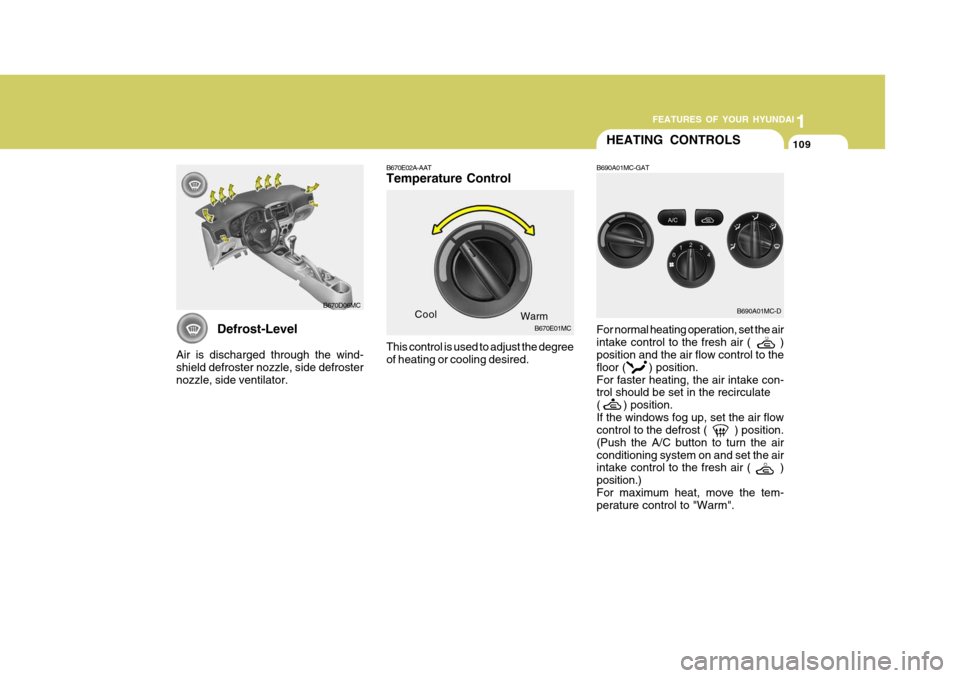
1
FEATURES OF YOUR HYUNDAI
109109109
Defrost-Level
Air is discharged through the wind- shield defroster nozzle, side defrosternozzle, side ventilator.
B670D06MC
HEATING CONTROLS
B690A01MC-GAT
B670E02A-AAT Temperature Control This control is used to adjust the degree of heating or cooling desired. For normal heating operation, set the air intake control to the fresh air ( ) position and the air flow control to the floor ( ) position.For faster heating, the air intake con- trol should be set in the recirculate ( ) position.If the windows fog up, set the air flow control to the defrost ( ) position. (Push the A/C button to turn the airconditioning system on and set the air intake control to the fresh air ( ) position.)For maximum heat, move the tem- perature control to "Warm".
Cool
Warm
B670E01MC B690A01MC-D
Page 122 of 284
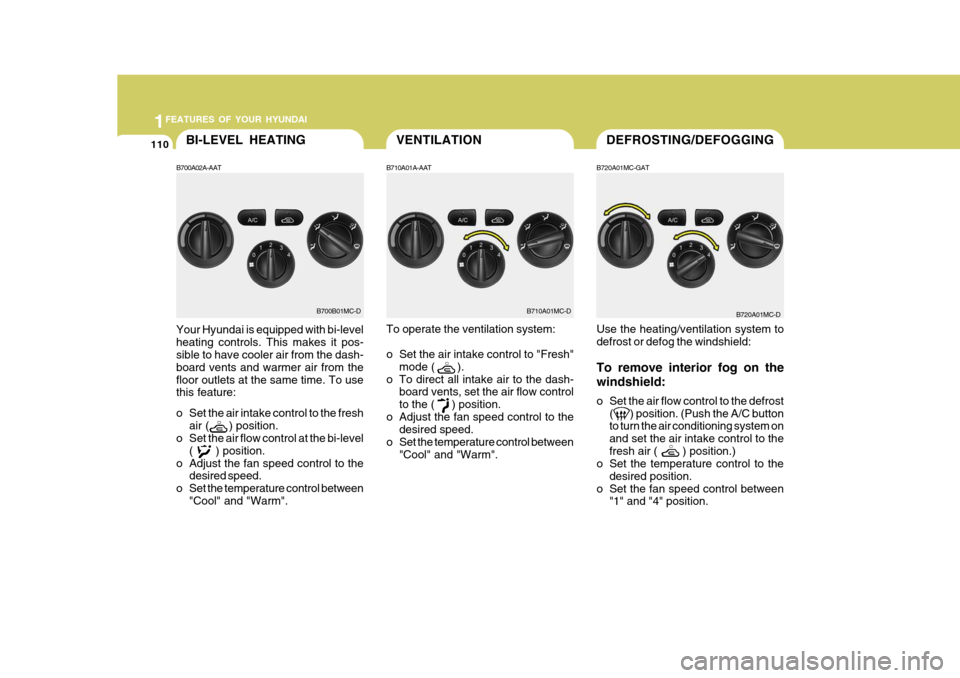
1FEATURES OF YOUR HYUNDAI
110DEFROSTING/DEFOGGINGVENTILATION
B720A01MC-GAT Use the heating/ventilation system to defrost or defog the windshield: To remove interior fog on the windshield:
o Set the air flow control to the defrost(
) position. (Push the A/C button
to turn the air conditioning system on and set the air intake control to thefresh air ( ) position.)
o Set the temperature control to the
desired position.
o Set the fan speed control between "1" and "4" position.
B710A01A-AAT
To operate the ventilation system:
o Set the air intake control to "Fresh"
mode ( ).
o To direct all intake air to the dash- board vents, set the air flow control to the (
) position.
o Adjust the fan speed control to the desired speed.
o Set the temperature control between "Cool" and "Warm".
B710A01MC-D B720A01MC-D
BI-LEVEL HEATING
B700A02A-AAT
Your Hyundai is equipped with bi-level heating controls. This makes it pos- sible to have cooler air from the dash- board vents and warmer air from thefloor outlets at the same time. To use this feature:
o Set the air intake control to the fresh air ( ) position.
o Set the air flow control at the bi-level
( ) position.
o Adjust the fan speed control to the desired speed.
o Set the temperature control between "Cool" and "Warm".
B700B01MC-D
Page 123 of 284
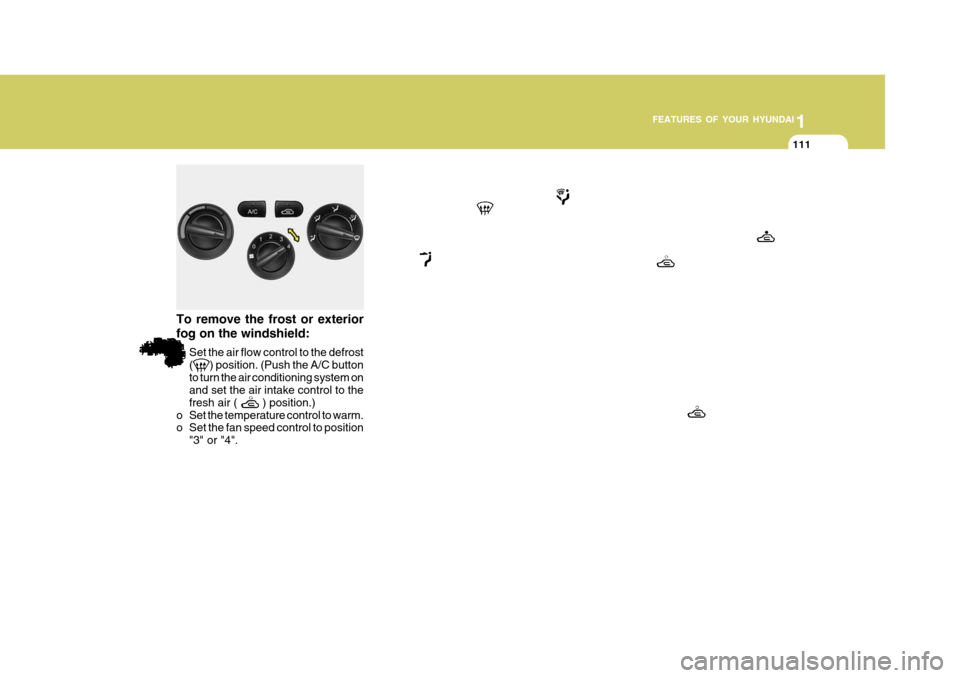
1
FEATURES OF YOUR HYUNDAI
111111111
To remove the frost or exterior fog on the windshield:
o Set the air flow control to the defrost (
) position. (Push the A/C button
to turn the air conditioning system on and set the air intake control to the fresh air ( ) position.)
o Set the temperature control to warm.
o Set the fan speed control to position "3" or "4".
B720A02MC-DNOTE:
When the A/C is operated continu-ously on the floor-defrost level ( )
or defrost level ( ), it may cause
fog to form on the exterior wind- shield. If this occurs, set the air
flow control to the face level posi-
tion ( ) and fan speed control to
the low position.B730A01L-AAT
Operation Tips
oTo keep dust or unpleasant fumes from entering the car through the
ventilation system, temporarily set the air intake control at the ( )
position. Be sure to return the control
to the ( ) position when the
irritation has passed to keep fresh air
in the vehicle. This will help keep the
driver alert and comfortable.
oAir for the heating/cooling system is drawn in through the grilles justahead of the windshield. Care should
be taken that these are not blocked
by leaves, snow, ice or other ob-
structions.
oTo prevent interior fog on the wind- shield, set the air intake control to
the fresh air ( ) position, fan
speed to the desired position, turn on the air conditioning system, and ad- just temperature control to desired
temperature.
Page 124 of 284
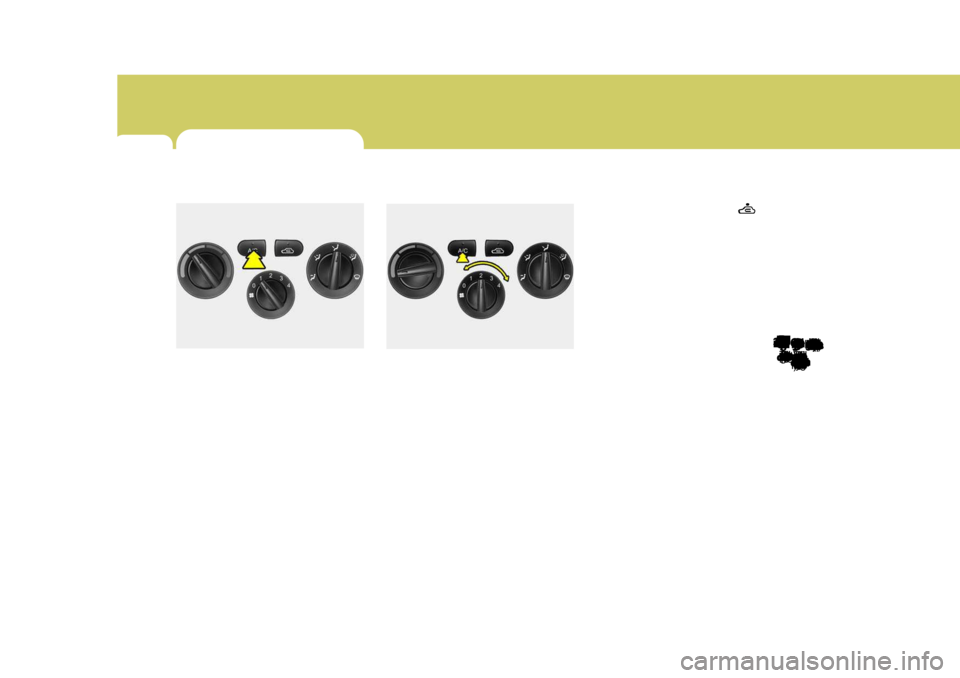
1FEATURES OF YOUR HYUNDAI112
B740B01MC-AAT
Air Conditioning Operation
(Cooling)
To use the air conditioning to cool the
interior:
oTurn on the fan control switch.
oPush the air conditioning switch by pushing in on the switch.
The air conditioning indicator light
should come on at the same time.
oSet the temperature control to "Cool". ("Cool" provides maximum cooling.
The temperature may be moderated
by moving the control toward "Warm".) oAdjust the fan control to the desired
speed. For greater cooling, turn the
fan control to one of the higher speeds
or temporarily select the ()posi-
tion on the air intake control.B740B01MC-D
AIR CONDITIONING SYSTEM
B740A01MC-D
B740A01A-AAT
(If Installed)
Air Conditioning Switch
The air conditioning is turned on by pushing the A/C button on the heating/ air conditioning control panel.
Page 125 of 284

1
FEATURES OF YOUR HYUNDAI113113113
For dehumidified heating: oTurn on the fan control switch.
oTurn on the air conditioning switch. The air conditioning indicator light
should come on at the same time.
oSet the air intake control switch to the fresh air (
) position.
oAdjust the fan control to the desired
speed.
oFor more rapid action, set the fan at one of the higher speeds.
oAdjust the temperature control to provide the desired amount of
warmth.
B740C01MC-AAT
De-Humidified HeatingB740C01MC-D
B740D01A-AAT
Operation Tips
oIf the interior of the car is hot when
you first get in, open the windows for
a few minutes to expel the hot air.
oWhen you are using the air condi-
tioning system, keep all windows
closed to keep hot air out.
oWhen moving slowly, as in heavy traffic, shift to a lower gear.
This increases engine speed, which in turn increases the speed of the air conditioning compressor.
oOn steep grades, turn the air condi- tioning off to avoid the possibility of
the engine overheating.
oDuring winter months or in periods when the air conditioning is not usedregularly, run the air conditioning
once every month for a few min-utes.
This will help circulate the lubricants
and keep your system in peak oper-
ating condition.
Page 129 of 284
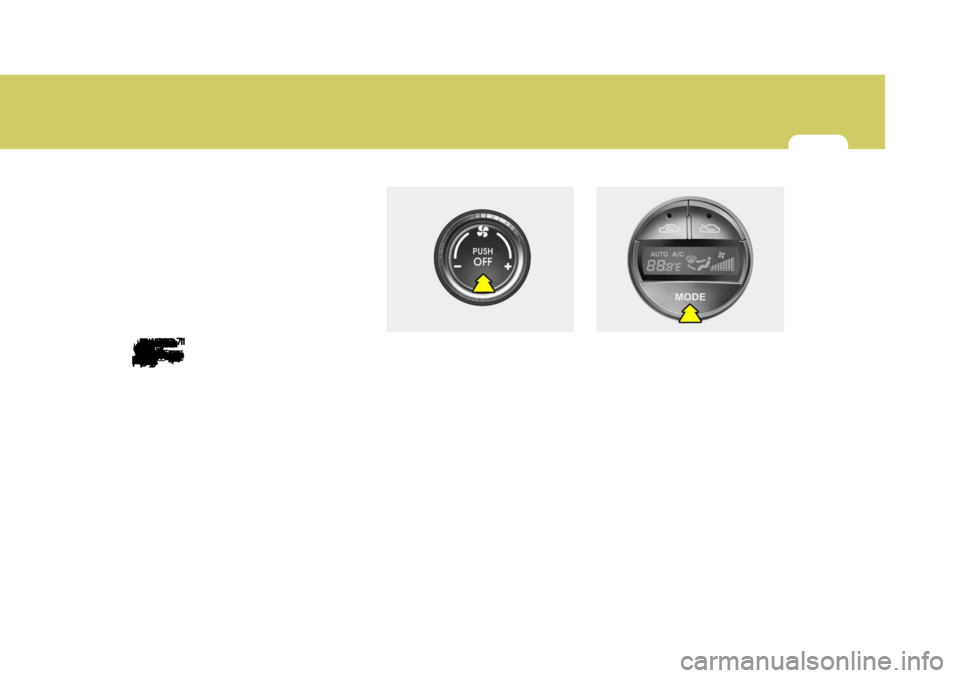
1
FEATURES OF YOUR HYUNDAI117117117
With the "Fresh" mode selected, air
enters the vehicle from the outside and
is heated or cooled according to the
function selected.
With the "Recirculation" mode selected,
air from within the passenger compart-
ment will be drawn through the heating
system and heated or cooled according to the function selected.
NOTE:
It should be noted that prolonged
operation of the heating system in "recirculation" mode will give rise to
fogging of the windshield and side
windows and the air within the pas-
senger compartment will become stale. In addition, prolonged use of
the air conditioning with the "Recir-
culation" mode selected may result
in the air within the passenger com-
partment becoming excessively dry.B980D01Y-AAT
Heating and Cooling System Off
Press the "OFF" switch to stop the operation of the heating and cooling
system. B980D01MCB980E01MC-GAT
Air Flow Control
This is used to direct the flow of air. Air
can be directed to the floor, dashboard
outlets, or windshield. Four symbols are used to represent Face, Bi-Level,Floor, Floor-Defrost position. B980E01MC
Page 182 of 284
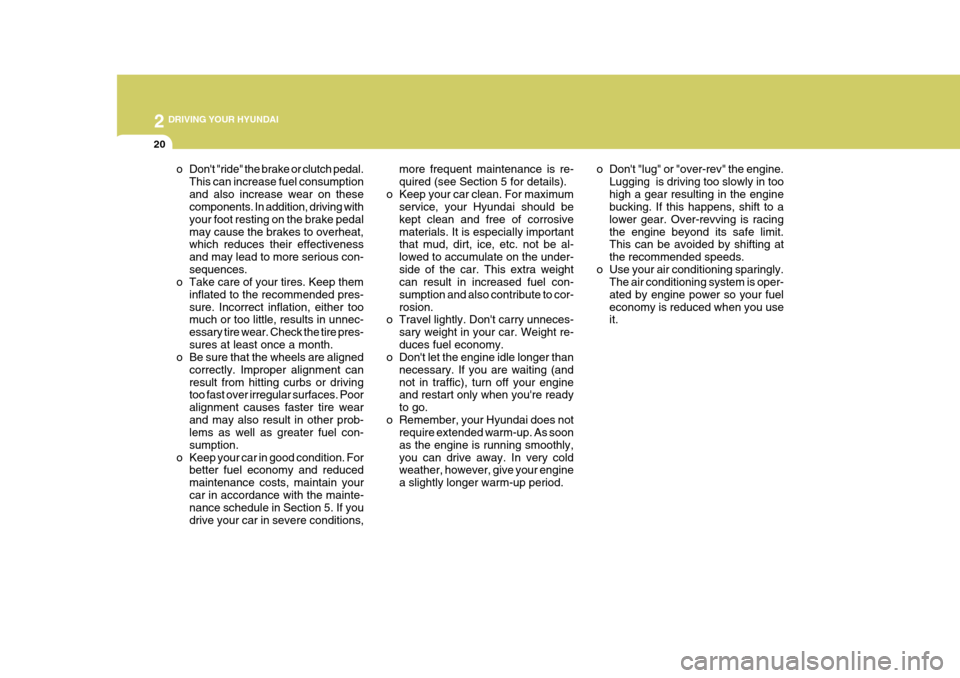
2 DRIVING YOUR HYUNDAI
20
o Don't "lug" or "over-rev" the engine.Lugging is driving too slowly in too high a gear resulting in the engine bucking. If this happens, shift to a lower gear. Over-revving is racingthe engine beyond its safe limit. This can be avoided by shifting at the recommended speeds.
o Use your air conditioning sparingly. The air conditioning system is oper-ated by engine power so your fueleconomy is reduced when you use it.
more frequent maintenance is re- quired (see Section 5 for details).
o Keep your car clean. For maximum service, your Hyundai should bekept clean and free of corrosivematerials. It is especially important that mud, dirt, ice, etc. not be al- lowed to accumulate on the under-side of the car. This extra weight can result in increased fuel con- sumption and also contribute to cor-rosion.
o Travel lightly. Don't carry unneces-
sary weight in your car. Weight re-duces fuel economy.
o Don't let the engine idle longer than
necessary. If you are waiting (andnot in traffic), turn off your engine and restart only when you're ready to go.
o Remember, your Hyundai does not require extended warm-up. As soonas the engine is running smoothly,you can drive away. In very cold weather, however, give your engine a slightly longer warm-up period.
o Don't "ride" the brake or clutch pedal.
This can increase fuel consumptionand also increase wear on these components. In addition, driving with your foot resting on the brake pedalmay cause the brakes to overheat, which reduces their effectiveness and may lead to more serious con-sequences.
o Take care of your tires. Keep them
inflated to the recommended pres-sure. Incorrect inflation, either too much or too little, results in unnec- essary tire wear. Check the tire pres-sures at least once a month.
o Be sure that the wheels are aligned
correctly. Improper alignment canresult from hitting curbs or driving too fast over irregular surfaces. Poor alignment causes faster tire wearand may also result in other prob- lems as well as greater fuel con- sumption.
o Keep your car in good condition. For better fuel economy and reducedmaintenance costs, maintain yourcar in accordance with the mainte- nance schedule in Section 5. If you drive your car in severe conditions,